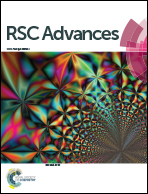A novel and sensitive turn-on fluorescent biosensor for the determination of thioctic acid based on Cu2+-modulated N-acetyl-l-cysteine capped CdTe quantum dots†
Abstract
A new fluorescence sensor for the determination of thioctic acid (TA) in aqueous media based on the recovered fluorescence of N-acetyl-L-cysteine capped CdTe quantum dots [NALC-CdTe QDs]–Cu2+ system was proposed. The fluorescence intensity of NALC-CdTe QDs was quenched by Cu2+ due to the binding of Cu2+ to NALC on the surface of the QDs. However, in the presence of TA, the fluorescence intensity of NALC-CdTe QDs was found to be efficiently recovered. Experimental results showed that the pH of the buffer solution and the concentration of Cu2+ affected the fluorescence intensity upon adding TA. Under the optimal conditions, the recovered fluorescence intensity was linearly proportional to the increasing TA concentration in the range 4–120 μg mL−1. In addition, among the other biologically relevant chemical species that were tested, only TA could turn on the fluorescence intensity suggesting that the [NALC-CdTe QDs]–Cu2+ system was a highly selective sensor for TA. Moreover, to further investigate the performance of the perfect analysis, the developed biosensor was applied to the determination of TA in its commercial samples and detected TA in the blood of a rabbit with the time extended.


 Please wait while we load your content...
Please wait while we load your content...